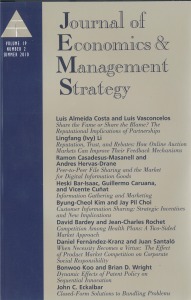Featured Article
2025
Spillovers in Crowdfunding
We use novel entrepreneur-backer data to study the extent to which spillovers arise between projects displayed on crowdfunding platforms. We find that backers decide to back a particular project based on past contributions not only to that project—as documented by prior work—but also to other contemporaneous projects—a novel result. Our difference-in-differences estimates indicate that such “cross-project spillovers” account for 4% in the increase of contributions that projects generate on a daily basis. We show that recurrent backers are an important transmission channel of cross-project spillovers: By initiating social learning about project existence and quality, recurrent backers encourage future funding by other backers. Our results demonstrate that even though contemporaneous projects compete for funding, they jointly benefit from their common presence on the platform. These findings have significant implications for digital platform management and competition dynamics.






